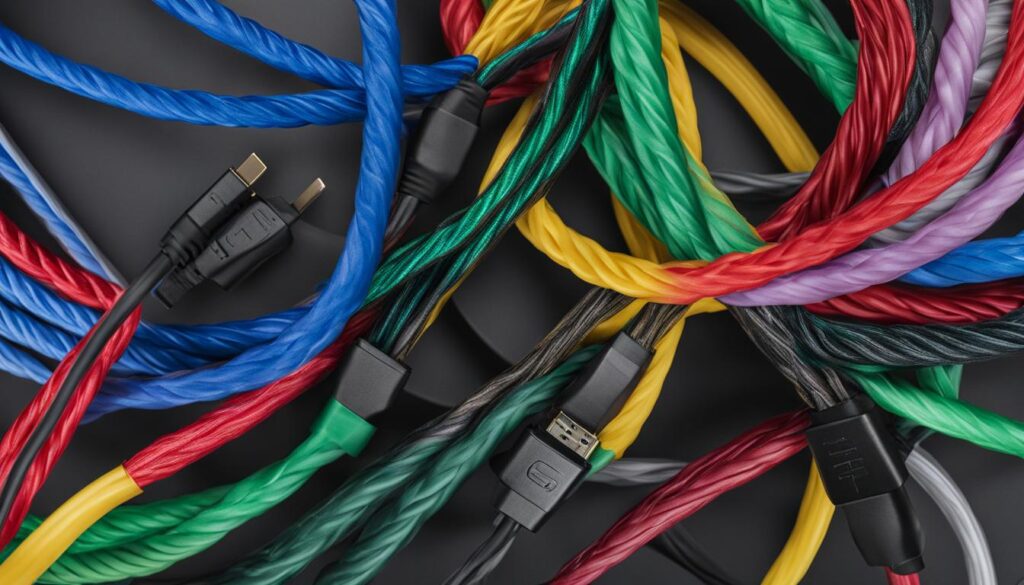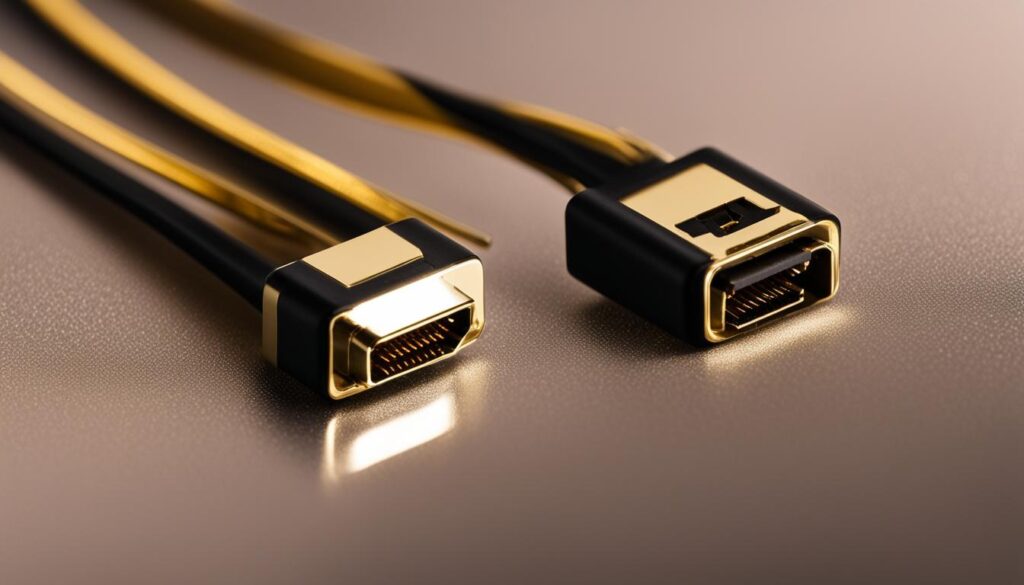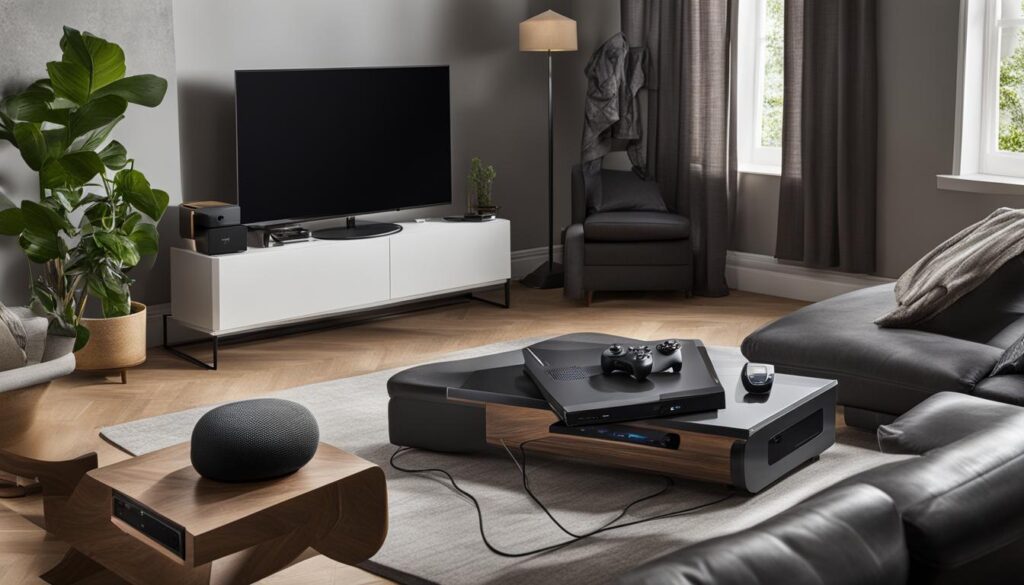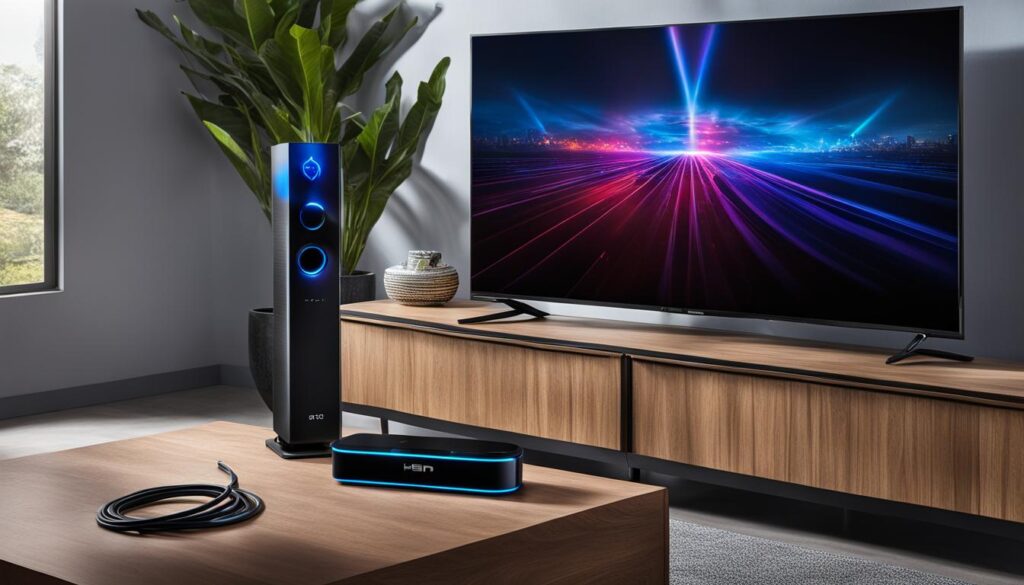Imagine the ease of connecting all your electronic devices with just a single cable that transmits pristine digital video and crisp audio transmission. This is the reality made possible by HDMI technology, the ubiquitous multimedia interface in almost every home and office. When you’re setting up your entertainment system or workstation, you’re likely dealing with HDMI cables – but do you know which one fits your needs?
HDMI stands for High-Definition Multimedia Interface and it has transformed how we connect our HDMI-enabled devices. These cables are not just conduits but the lifeline for transmitting high-definition content from your gaming consoles, Blu-ray players, laptops, and more, to your monitors, TVs, and projectors. With HDMI, you get to experience the full potential of your digital content, thanks to the various types of connectors and a range of supported resolutions.
Whether it’s a classic film, a riveting TV show, or a fast-paced game, HDMI ensures that you enjoy it with the highest quality of video and audio—a feat that analog cables couldn’t accomplish. So, let’s hook up your HDMI-enabled devices and delve into the world of clear, uninterrupted audiovisual pleasure that HDMI brings right into your living room.
Key Takeaways
- HDMI cables are the cornerstone for digital video and audio transmission, connecting a wide array of multimedia devices.
- Understanding the variety of HDMI connectors and resolutions is key to fully optimizing your home theater or computer setup.
- Technological advancements in HDMI have made it a staple in current generation TVs and monitors.
- The right HDMI cable will ensure you experience the full clarity and sound quality that your devices are capable of delivering.
- Knowing the specs of your HDMI-enabled devices is crucial for selecting the proper HDMI cable to suit your requirements.
A Brief History of HDMI Technology
When the HDMI initiative was launched in 2002, it paved the way for a digital interface revolution, aiming to improve the way audio and video signals were transmitted from devices to displays. This single-cable solution promised to clear the clutter and simultaneously provide superior audio and video quality over analog interfaces. The HDMI standard evolution that began with HDMI 1.0 has come a long way, reflecting continuous innovation and widespread industry adoption.
By catapulting the integration of the audio/video interface in consumer electronics, HDMI enabled high-quality, uncompressed digital signals to move seamlessly between sources like DVD players and TV sets. Within six years of its introduction, the HDMI standard had already superseded older technologies, such as DVI, in terms of device shipments. This was a testament to the industry and consumer affirmation of HDMI’s superior capabilities.
- The HDMI 1.0 release marked the birth of the interface, starting with the capacity to transfer data at 4.95 Gbps and introducing new technological pillars such as HDCP (High-Bandwidth Digital Content Protection) for secure content transmission.
- As screens evolved, HDMI technology kept pace, expanding solutions like CEC (Consumer Electronics Control) allowing for integrated system control across various devices using just one remote.
- With HDMI 2.1, data transmission hit remarkable speeds of up to 48 Gbps, facilitating support for resolutions as impressive as 10K and adapting to the ultra-high-definition needs of the future.
Crucial for maintaining signal integrity across lengthening cables was the introduction of TMDS (Transition-Minimized Differential Signaling), ensuring that your entertainment and workstations would not suffer from quality degradations due to electronic noise. Furthermore, technologies like EDID (Extended Display Identification Data) have enabled devices to communicate their capabilities, promoting smooth configuration and optimal performance.
As monitor refresh rates increased and the gaming world demanded more, HDMI adapted by incorporating DSC (Display Stream Compression), allowing for high refresh rates without sacrificing color depth or resolution.
| HDMI Version | Year of Release | Maximum Data Transfer Rate | Notable Features |
|---|---|---|---|
| 1.0 | 2002 | 4.95 Gbps | Audio/video interface, HDCP |
| 1.1 | 2004 | 4.95 Gbps | Added support for DVD Audio |
| 1.3 | 2006 | 10.2 Gbps | Deep Color, CEC |
| 1.4 | 2009 | 10.2 Gbps | Ethernet over HDMI, Audio Return Channel |
| 2.0 | 2013 | 18 Gbps | 4K at 60 Hz, Dynamic synchronization of video and audio |
| 2.1 | 2017 | 48 Gbps | 10K resolution, Enhanced Audio Return Channel, VRR |
In your quest to understand HDMI and its impact on modern digital connectivity, it becomes clear that HDMI is not just a cord; it’s a journey of technological triumph that has fundamentally transformed the digital landscape, delivering an unrivaled audio-video experience to your doorstep. And as you continue to engage with the world through various screens, HDMI remains imperative, steadfastly connecting you to the vast digital universe.
Exploring HDMI Cable Types and Their Capabilities
Understanding the different types of HDMI cables and their specific features can be pivotal to your home entertainment and professional setup. Cables vary by resolution, bandwidth, and functionality, so it’s essential to choose the right one to fit your needs.
From Standard to Ultra High-Speed: Bandwidth and Resolution Explained

Starting with the Standard HDMI, these cables are sufficient for transferring 1080i or 720p video signals with a bandwidth up to 4.95 Gbps. As we ascend the quality ladder, High-Speed HDMI cables allow you to enjoy 1080p or 4K resolution at 30 Hz with a bandwidth of 10.2 Gbps.
For a higher level of clarity, the Premium High-Speed HDMI cables cater to 4K content at 60 Hz using an 18 Gbps datarate for a richer viewing experience. Not to be outdone, Ultra High-Speed HDMI cables boast bandwidth capabilities up to 48 Gbps, able to deliver visually stunning 8K60 and 4K120 resolutions, perfect for intricate details and fast-paced action, complete with HDR enhancements.
| Cable Type | Resolution | Refresh Rates | Bandwidth (Gbps) |
|---|---|---|---|
| Standard HDMI | 1080i, 720p | – | 4.95 |
| High-Speed HDMI | 1080p, 4K30 | – | 10.2 |
| Premium High-Speed HDMI | 4K60 | – | 18 |
| Ultra High-Speed HDMI | 8K60, 4K120 | – | 48 |
The Importance of Cable Certification: Identifying Genuine HDMI Products
Cable certification ensures that the HDMI cables you purchase will provide the quality you expect. Premium HDMI Cable Certification and Ultra High-Speed HDMI Certification are not just trademarks; they are badges of proof that the HDMI Licensing Administrator has rigorously tested the cables to ensure they deliver the speeds and resolutions they advertise.
- Look for certification labels with holographic fingerprints and QR codes.
- Check your HDMI cable’s certification to ensure compatibility with your devices.
- Purchasing certified cables reassures that you’re investing in genuine HDMI products that meet industry standards.
Understanding Cable Lengths and Signal Quality
The correct length of your HDMI cable can have a significant effect on signal quality. Standard passive HDMI cables can reliably transmit high-quality signals for distances of up to 25-50 feet, depending on resolution and bandwidth.
However, if your setup requires longer cable distances, you might need an active cable or an HDMI extender to maintain signal integrity. For those considering in-wall HDMI installations, cables with a CL2 or CL3 rating are suitable for low-voltage use and comply with fire safety regulations, ensuring a secure setup over long distances without compromising on resolution or signal strength.
Deciphering HDMI Connectors: Type A, Type C, Type D, and Beyond
When it comes to setting up your home entertainment system or gaming setup, understanding the different HDMI connector types is essential. Each connector, characterized by its unique size and pin configuration, serves a specific purpose and caters to different devices. Let’s decode the various HDMI connectors to ensure you pick the right one that matches your setup’s requirements.
The most common HDMI connectors you are likely to encounter include Type A HDMI, Type C HDMI (Mini), and Type D HDMI (Micro). Those seemingly small differences in HDMI sizes have large impacts on the functionality and versatility of your devices.

Type A HDMI connectors are the standard in most TVs, gaming consoles, and media players. Designed with a 19-pin configuration, these connectors provide high-speed transmission and are fitted to handle most audiovisual tasks with ease. But the world of HDMI doesn’t end there. For your portable devices, you’ll find the Mini and Micro connectors, which pack the same pin configuration into a smaller form.
| Connector Type | Primary Use | Pin Configuration | Special Features |
|---|---|---|---|
| Type A (Standard) | TVs, Gaming Consoles, Media Players | 19-pin | High-speed transmission, widespread use |
| Type C (Mini) | Portable Devices | 19-pin | Compact size for mobile usability |
| Type D (Micro) | Smartphones, Action Cameras | 19-pin | Ultra-compact design for small devices |
| Type E (Automotive) | Vehicles, Industrial | 19-pin | Locking tab for secure connection in vibration-prone environments |
Aside from these commonly used types, there is the HDMI Type E, designed with a locking mechanism for automotive and industrial applications, ensuring connections stay secure even in the most adverse conditions.
Now, what about the seldom-seen HDMI Type B? This connector was developed for very high-resolution displays using a dual-link configuration, but as technology evolved, its utilization became less common. On the flip side, HDMI sizes and standards have adapted to include Alternate Modes, such as HDMI Alt Mode for USB-C, expanding connectivity options and essentially future-proofing HDMI technology.
Whether you’re a professional videographer requiring HDMI connector types that support the highest resolutions or a casual user connecting a smartphone to your HDTV, there’s an HDMI for that. The innovative alternate modes, like the USB-C Alt Mode, mean you can even transmit HDMI signals through USB-C ports, epitomizing HDMI connectors’ versatility. Make sure your next purchase considers these critical aspects of HDMI connectors to fully harness the potential of your digital experiences.
HDMI Cable Applications: Home Theater to Gaming and Beyond
Within the intricate world of digital connectivity, HDMI cables serve as vital links in home theaters, gaming setups, and professional environments. Their versatile applications range from delivering crystal-clear audiovisual experiences to ensuring the finest detail in professional settings. Let’s explore the various realms where HDMI cables play an integral role.
Home Entertainment Systems: TVs, Blu-ray Players, and Streamers
Your home theater is only as good as the connections it boasts. With HDMI cables, you can interconnect various devices in your entertainment hub. Imagine connecting your 4K TV with the latest Blu-ray player or HDMI streamers to unravel high-definition thrills. HDMI serves as the lifeline for these setups, transmitting top-tier video clarity paired with dynamic, theater-quality sound.
- Improve your HDTV experience with seamless HDMI connections.
- Enjoy high-definition movies from your Blu-ray player, thanks to reliable HDMI technology.
- Stream the latest content in an immersive format with HDMI-enhanced media devices.
Gaming Consoles: PlayStation, Xbox, and High-Frame-Rate Gaming
The edge you need in gaming, whether in the lands of fantasy or competitive sports domains, is brought forth by the prowess of HDMI cables. HDMI 2.1’s introduction into the gaming realm has been revolutionary, granting consoles like PlayStation and Xbox the ability to push for 4K60 and even 4K120 gameplay. Features like VRR and ALLM optimize the gaming experience, eradicating lag and providing the smoothest visuals for high-frame-rate gaming.
- Dive into high-frame-rate gaming on your PlayStation or Xbox with HDMI 2.1.
- Experience enchanting graphics performance for a competitive edge in gaming.
- Enable 4K120 gaming sessions for ultimate immersion and reaction speed.
Professional Use: Monitors, AV Receivers, and Digital Signage
In professional spheres, quality and reliability are the benchmarks of excellence. HDMI cables bind the intricate network of high-resolution monitors, AV receivers, and digital signage systems. Whether for corporate presentations, videography, or in-store advertising, HDMI ensures that your high-resolution displays and professional video equipment exhibit maximum fidelity.
- Connect high-end monitors for unparalleled visual precision in creative projects.
- Integrate sophisticated AV systems using HDMI’s broad bandwidth for top-tier audiovisual replication.
- Drive customer engagement through digital signage, powered by HDMI’s ability to transmit high-definition content.
The profound influence of HDMI in crafting rich and dynamic media landscapes is undeniable. Whether for personal leisure or professional use, it is the thread that weaves your digital life into a tapestry of immersive experiences. As we venture forward, HDMI’s evolution continues to harmonize with the expanding frontiers of home entertainment, gaming, and professional media.

| Device | Type | HDMI Version | Key Feature |
|---|---|---|---|
| TVs, Video Projectors | Home Theater | 2.0, 2.1 | 4K, 8K Resolution, HDR |
| Blu-ray Players | Home Theater | 2.0, 2.1 | HD Audio and Video |
| Media Streamers | Home Theater | 2.0, 2.1 | Streaming in Ultra HD |
| PlayStation, Xbox | Gaming | 2.1 | VRR, ALLM for Gaming |
| Monitors, AV Receivers | Professional Use | 2.0, 2.1 | High-Resolution Support |
| Digital Signage | Professional Use | 2.0, 2.1 | Long-distance Transmission |
Advanced HDMI Features: eARC, Ethernet, and HDR Support
As digital entertainment evolves, the HDMI technology powering our visual and auditory experience continues to innovate. Among the advancements, certain HDMI advanced features stand out, specifically designed to enhance your overall multimedia experience. Discover the benefits of HDMI 2.1 features including HDMI eARC, HDMI Ethernet Channel (HEC), and HDMI HDR. These features are not only hallmarks of a superior setup but are also integral for future-proofing your home theater system.
Understanding the Enhanced Audio Return Channel, or HDMI eARC, is crucial. This feature, an improvement over the previous ARC, provides a significant boost in audio quality and user convenience. HDMI eARC simplifies the cabling process between your TV and audio system and enables the support for high-bitrate audio formats, delivering an uncompressed sound that matches the visual spectacle of your favorite content.
What about data? The HDMI Ethernet Channel (HEC) allows your HDMI cable to carry network data, meaning fewer cables in your entertainment center. Although not widely implemented, the feature reflects HDMI’s commitment to reducing cable clutter and simplifying connections.
When it comes to HDMI HDR, or High Dynamic Range, HDMI cables are equipped to handle the increased bandwidth necessary for displaying a more expansive range of colors and contrast levels. This leads to richer, more lifelike images that make the most of your HDR-compatible displays.

- HDMI eARC allows for high-bitrate audio formats, such as DTS Master, DTS:X, Dolby TrueHD, and Dolby Atmos.
- HDMI Ethernet Channel (HEC) features a 100 Mb/sec Ethernet connection shared between compatible devices.
- HDMI HDR supports a broader spectrum of colors and contrasts, essential for a superior visual experience.
Below is a comparative table that highlights the HDMI specifications and how these advanced features contribute to a high-end audiovisual setup:
| Advanced Feature | Description | HDMI Specification | Benefit to Users |
|---|---|---|---|
| HDMI eARC | Enhanced Audio Return Channel | HDMI 2.1 | Simplifies audio setup and supports the highest audio formats |
| HDMI Ethernet Channel (HEC) | Network data transmission | HDMI 1.4 and above | Reduces cable requirements and connects devices over Ethernet |
| HDMI HDR | High Dynamic Range imaging | HDMI 2.0a and above | Enables more vivid colors and higher contrast |
With these HDMI advanced features at your disposal, you can be confident that your system is equipped for the exceptional media experience that you deserve. Whether immersing yourself in a movie with stunning HDR colors or feeling right in the middle of the action with dynamic, high-fidelity audio, HDMI eARC, HDMI HEC, and HDMI HDR are your keys to unlocking the full potential of your home entertainment setup.
Choosing the Right HDMI Cable for Your Needs
When you’re selecting the perfect HDMI cable for your advanced visual and audio setup, the variety of options might seem overwhelming. Whether you’re setting up a home theater or enhancing your gaming experience, choosing HDMI cables that match your system’s capabilities is crucial. For instance, if immersive 4K content is what you’re after, you’ll want a Premium High-Speed HDMI cable, which guarantees you a viewing experience with crystal-clear quality at your peak resolution.
If you’re delving into the world of 8K, your equipment deserves nothing less than an Ultra High-Speed HDMI cable. This ensures that your cable is no bottleneck, but rather a conduit for the highest fidelity content, bolstering refresh rates and expansive color ranges. And, it’s not just about the highest resolutions—you need the right HDMI cable length. A common misconception is that longer is always better. However, unnecessary extra length can lead to potential signal degradation and clutter. So, consider the layout of your devices and choose a cable just as long as you need, no more, no less.
Another pro tip: the price of HDMI cables does not always correlate with quality. Luckily, high-performance HDMI cables come at various price points, allowing you to select one that fits both your needs and your budget. The key is to look for certified HDMI cables. These cables have been tested to meet specific standards needed for modern high-definition content. HDMI cable buying tips can be distilled to this—ensure your purchase has the necessary certification for the desired HDMI version to avoid being short-changed, performance-wise. Whether you’re syncing up your PlayStation for 4K gaming or connecting your new streaming device, the importance of selecting the right cable cannot be understated.
